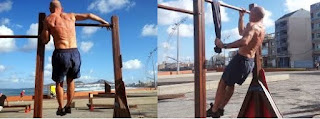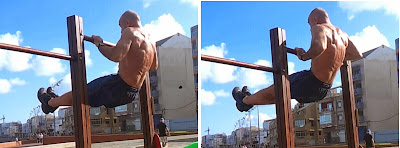Choose one of the following variations as a starting point and perform 3 sets of between 4 and 8 repetitions with periods of between 1 and 2 min of rest between each set. When you can do 3 sets of 8, move on to the next exercise in the progression.
All the necessary information about pull up can be find in my previous article here.
Pull ups progression to One arm Pull up
1. Australian Pull up / Horizonal Pull up
 |
| Australian Pull up |
Find a horizontal base you can hold onto which will safely carry your bodyweight. It needs to
be at least as high as your hips.
Get down so that your chest and lower body are underneath the bar.
Ideally your hands should be shoulder width. Now pull yourself up so that your back is off the floor. Depending upon the height of the bar, your arms will probably have to be slightly bent for this. Keep your body tensed and locked straight, so that its weight goes only thorough your hands and heels.
2. Negative / Eccentrics Pull ups
Jump up in the pull up position with your chin above the bar, then slowly lower yourself down to the count of 5 seconds.3. Half Pull ups (top half)
Start in mid range, and pull yourself up through half the range of motion, until your chin clears the bar. Then lower yourself back to mid range (elbows bent at 90 degrees).4.Full Pull ups
You can see the proper form here.5. Uneven Pull ups / Archer Pull ups
Focus on pulling with one arm, with minimal assistance from the other. The other arm should gradually straighten over the bar during the pulling motion. Only go up to 6 on each arm, alternating each arm, rather than the 8 reps the basic routine calls for.6. One arm assisted Pull ups.
The lower your grip is on the towel, the less assistance your other arm will actually provide. Also try to modify your grip on the towel to reduce the assitance (hold with only 2 fingers for instance). Only go up to 6 reps on each arm, alternating each arm, rather than the 8 reps the basic routine calls for.Or you can choose Weighted Pull up. Both are awesome.
 |
| Archer Pull up and one arm assisted Pull up |
7. Nagative / Eccentrics One Arm Pull-Ups
Using a chair, or perhaps jumping high enough, get yourself to the top of the pull-up position. Slowly lower yourself. Your eventual goal should be to lower yourself slow enough so that it takes 5-10 seconds or more to get from top to bottom.8. One arm Pull ups
 |
| One arm Pull up |
Grab the bar with one arm. Pull yourself up. Slowly lower yourself back down, and go think about how awesome you are. :)))
Pull up progression to Muscle up
Do the same steps to get the full pull ups, then move to these variation.
For a detailed guide for Muscle ups, click here.
5. L-sit Pull ups
Doing full pull ups with your leg parallel to the ground. Your core must works much harder.
6. High Pull ups
Chest pull ups shifts the emphasis away from the latissimus dorsi, but it is another key step in the progression towards a muscle up. Perform a pull up until the bar is at chest level. Make sure your elbows remain close to your body throughout the later part of the move, and that they drive back past your shoulders.Belly pull up is executed the same way but pull more explosively until your belly button is level with the bar.
 |
| High Pull ups |
7. Eccentrics / Negative Muscle up
Use a chair or other object to get to the top of a muscle-up position. Slowly lower yourself down so that you are hanging from the bar.8. Kipping Muscle up
Hang from a bar. Swing your legs up to create momentum, and use that momentum to pull yourself up and over the bar, then straighten your arms. Work on using less and less momentum. |
| Kipping muscle up |
Comments
Post a Comment